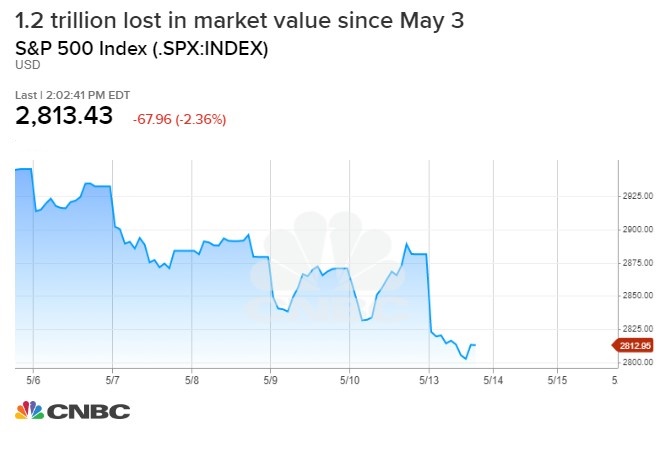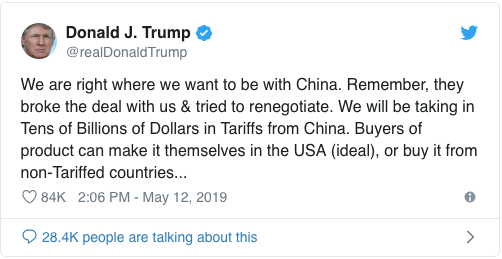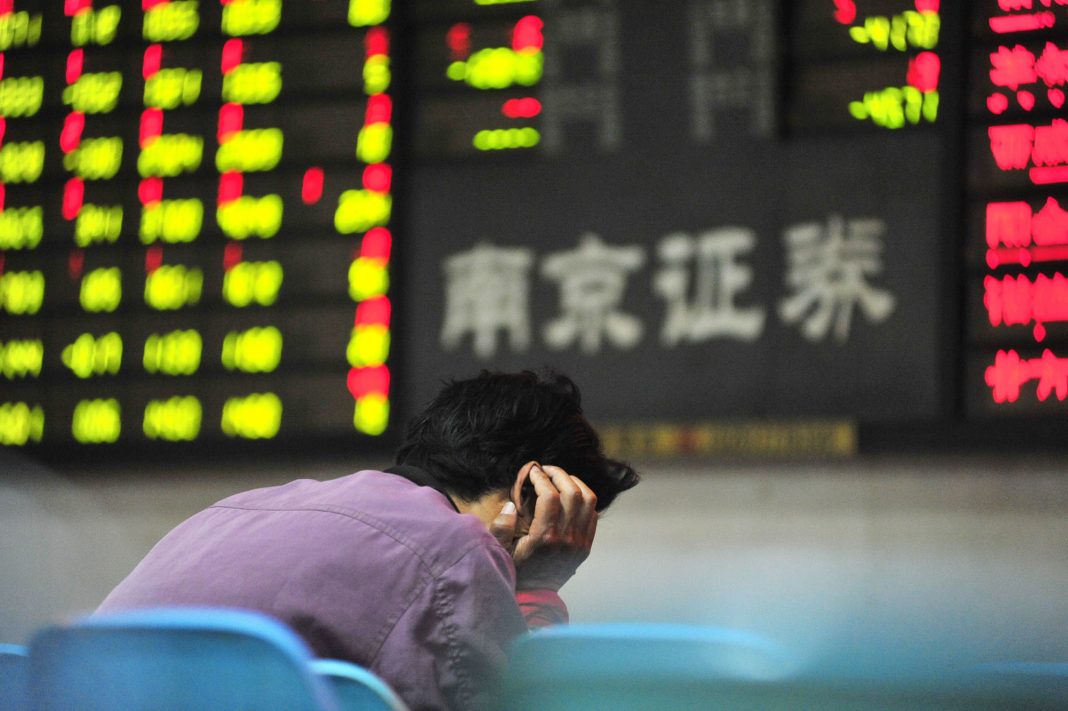KEY POINTS
- The S&P 500 has lost $1.2 trillion in value since the weekend before last, when President Donald Trump surprised investors with tweets threatening new tariffs on China.
- Trade talks then appeared to rather publicly hit a wall, with Trump and U.S. negotiators saying China is attempting to renegotiate major aspects of a deal.
- Now strategists expect a bigger stock market decline, as investors assess the impact of tariffs and retaliatory moves on the global economy and corporate earnings.
Stocks plunged Monday on fears the trade war will now last longer and escalate further, damaging the global economy and crushing corporate profit growth.
Large cap stocks, or those in the S&P 500, have now lost $1.2 trillion since President Donald Trump surprised markets with the May 5 weekend tweetsthat said he was thinking of raising tariffs on Chinese goods.
As China retaliated against the latest U.S. tariffs Monday, the Dow and S&P 500 were both down more than 2% and investors fled to bonds and other safe haven trades like gold.

Market strategists predict more pain for stocks ahead, as the market prices in a more extended view of the trade battle that looked to be just a skirmish a week ago. Since his weekend threat, President Donald Trump forged ahead with higher tariffs on $200 billion in Chinese goods and says he will move forward with new tariffs on all China imports, goods totaling about $325 billion more.
China retaliated by raising tariffs on $60 billion in goods. As of June 1, Beijing will increase tariffs on more than 5,000 products to as high as 25%. Duties on some other goods will increase to 20%. Those rates will rise from either 10% or 5% previously. Products hit by the 25% tariffs include animal products and frozen fruits and vegetables. Chemicals are among goods to be taxed at 20%.
“Our view is this could escalate for at least a matter of weeks, if not months, and it’s really to get the two back to the negotiating table and finish the deal, is probably going to require more pain in the markets…Really the only question is if we need a 5%, 10% or bigger market correction,” said Ethan Harris, head of global economics at Bank of America Merrill Lynch.
The Dow, at its low, was down more than 700 points , or 2.7%, and the S&P 500 also was down 2.7%. But the Nasdaq lost more 3.5%, as the sell-off was led by tech and other industries sensitive to U.S.-China trade. Tech was down as much as 3.7%, while industrials were down 3.4%.
As stocks sold off, investors ran to the safety of Treasurys, and the 10-year yield fell to 2.39%. At the same time, the futures market was pricing in a full 25-basis point Fed rate cut for this year and most of one for next year, according to BMO.Where’s the bottom?
Julian Emanuel, head of equities and derivatives strategy at BTIG, said the market could have further to fall, and he doesn’t expect it to stop until the CBOE’s VIX, a measure of puts and calls, rises to 30. The VIX, commonly viewed as a fear meter, was up 32%, just above 21.
“We see downside risk to 2775, the S&P’s 100-day moving average, more importantly 2,600 is an area of previous support,” said Emanuel. A decline to 2,600 would be about 7%. “Trying to pick a level in the market is much more difficult. What we really want to see is a degree of fear. To us that degree of fear right now is represented by the VIX trading up to 30, which we think will happen at some point in the near to medium term.”
Emanuel said some chart analysts see a potential double top in the S&P, a negative sign for stocks, and there are unresolved divergences among indexes. For instance, the small cap Russell 2000, the Dow and the Dow Transports never recovered their highs, as the S&P 500 reached an all-time high May 3. Since then, it lost more than 5%.
Market sentiment sours “when you combine [trade] with the threat from Iran and the idea of EU parliamentary elections which begin May 23 and could bring the right wing nationalists into more focus, plus the psychological damage that occurred at the highs when the Fed was viewed as being less supportive than the market believed, plus the divergences.”
He expects the S&P 500 to reach 3,000 by the end of the year, but he does see the Fed cutting interest rates and that will help market sentiment even before the central bank acts. The Fed, itself, says it is on hold this year, and Fed Chairman Jerome Powell and others have indicated the Fed does not see a reason to cut rates for now.‘Brinksmanship’
Many investors believe the Trump ‘put’ will prevent the market from falling too much. The so-called ‘put’ is the belief that Trump will take action of the stock market is falling too much.
“The problem with the Trump put is it stretches out the battle,” said Harris. “You can’t trigger the put without the market going down and so, ironically, the belief in the Trump put stretches the whole brinksmanship battle out further. You have to kind of think of this as a back and forth between the markets and the policy makers on both sides.”
Harris notes that the latest round of trade talks came together, just after stocks collapsed in the last week of December.
Emanuel said the stock market is reacting to the fear that trade war will now be extended enough to do more and deeper damage to the economy, particularly if more tariffs are launched or China finds other ways to hurt U.S. companies on its home turf.
“The whole idea that you could skate through the trade war with no adverse effect, we already saw the adverse effects in the fourth quarter of last year in the stock market,” Emanuel said. “In our view, it’s actually been an adverse affect in the first quarter of 2019 with this massive plunge in yields in the U.S. as a result of global weakness in the bond market which reinforces the disinflationary mindset of the Fed.”
Over the weekend, Trump continued to tweet about China, blaming it for the breakdown that has delayed a deal that was expected this month.

Emanuel said some chart analysts see a potential double top in the S&P, a negative sign for stocks, and there are unresolved divergences among indexes. For instance, the small cap Russell 2000, the Dow and the Dow Transports never recovered their highs, as the S&P 500 reached an all-time high May 3. Since then, it lost more than 5%.
Market sentiment sours “when you combine [trade] with the threat from Iran and the idea of EU parliamentary elections which begin May 23 and could bring the right wing nationalists into more focus, plus the psychological damage that occurred at the highs when the Fed was viewed as being less supportive than the market believed, plus the divergences.”
He expects the S&P 500 to reach 3,000 by the end of the year, but he does see the Fed cutting interest rates and that will help market sentiment even before the central bank acts. The Fed, itself, says it is on hold this year, and Fed Chairman Jerome Powell and others have indicated the Fed does not see a reason to cut rates for now.‘Brinksmanship’
Many investors believe the Trump ‘put’ will prevent the market from falling too much. The so-called ‘put’ is the belief that Trump will take action of the stock market is falling too much.
“The problem with the Trump put is it stretches out the battle,” said Harris. “You can’t trigger the put without the market going down and so, ironically, the belief in the Trump put stretches the whole brinksmanship battle out further. You have to kind of think of this as a back and forth between the markets and the policy makers on both sides.”
Harris notes that the latest round of trade talks came together, just after stocks collapsed in the last week of December.
Emanuel said the stock market is reacting to the fear that trade war will now be extended enough to do more and deeper damage to the economy, particularly if more tariffs are launched or China finds other ways to hurt U.S. companies on its home turf.
“The whole idea that you could skate through the trade war with no adverse effect, we already saw the adverse effects in the fourth quarter of last year in the stock market,” Emanuel said. “In our view, it’s actually been an adverse affect in the first quarter of 2019 with this massive plunge in yields in the U.S. as a result of global weakness in the bond market which reinforces the disinflationary mindset of the Fed.”
Over the weekend, Trump continued to tweet about China, blaming it for the breakdown that has delayed a deal that was expected this month.

























